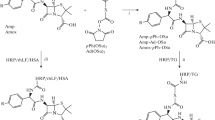Abstract
Monoclonal antibodies (McAbs) against chloramphenicol (CAP) were produced to detect CAP residues, which could be toxic and possesses a potential threat to human health. The CAP-BSA conjugate was obtained by bovine serum albumin (BSA) coupled with CAP, and used to immunize the mice. The splenocytes from the immunized mice were fused with mouse myeloma cells SP2/0 to form hybridoma, which may secrete McAbs against CAP. Hybridomas 1D1 and 3G12 secreting McAbs against CAP were obtained by screening. Ascites containing McAbs were prepared by injecting 1 x 106 cells of hybridoma 1D1 and 3G12 into the abdomen of mice. Protein A affinity chromatography was used to purify McAbs against CAP in a single chromatographic step with recovery yield above 80% and purity above 95% and full recovery of antibody activity. Experiments showed that McAb 3G12 was highly specific for CAP and had no cross-reactivity with analogues which have a structure similar to CAP. The IC50 value was 50.8 ng/mL.




Similar content being viewed by others
References
Allen EH (1985) Review of chromatograpic methods for chloramphenicol residues in milk, eggs, and tissues from food-producing animals. J AOAC Int 68:990–999
ANON (2002) USFDA improvises testing for chloramphenicol in seafood. Seaf Export J 10:5
Bononi M, Tateo F (2008) Liquid chromatography/tandem mass spectrometry analysis of chloramphenicol in propolis extracts available on the Italian market. J Food Compos Anal 21:84–89
D’Agostino B, Bellofiore P, De Martino T, Punzo C, Rivieccio V, Verdoliva A (2008) Affinity purification of IgG monoclonal antibodies using the D-PAM synthetic ligand: chromatographic comparison with protein A and thermodynamic investigation of the D-PAM/IgG interaction. J Immunol Methods 333:126–138
Dirnhofer S, Klieber R (1993) Functional and immunological relevante of the C-terminal extension of human chorionic gonadotrophin beta: implications for the WHO birth control vaccine. Faseb J 7:381–385
Dong Q, Wen L, Wu JX, Lian Y (2006) Preparation of monoclonal antibody against Macrobrachium rosenbergii Nodavirus and application of TAS-ELISA for virus diagnosis in post-larvae hatcheries in east China during 2000–2004. Aquaculture 261:1144–1150
Erlanger BF (1980) The preparation of antigenic hapten-carrier conjugates: a survey. Method Enzymol 70:85–104
Farombi EO (2001) Antioxidant and hepatic lipid peroxidation in chloramphenicol treated rats. Tohoku J Exp Med 194:91–98
Fergusona J, Baxter A, Young P, Kennedy G, Elliott C, Weigel S, Gatermann R, Ashwin H, Stead S, Sharman M (2005) Detection of chloramphenicol and chloramphenicol glucuronide residues in poultry muscle, honey, prawn and milk using a surface plasmon resonance biosensor and Qflex® kit chloramphenicol. Anal Chim Acta 529:109–113
Franklin TJ, Snow GA (1989) Biochemistry of antimicrobial action, 4th edn. Chapman & Hall, London, p 128
Gao AZ, Chen QL, Cheng L, Lei J, Zeng LW (2007) Preparation of monoclonal antibodies against a derivative of semicarbazide as a metabolic target of nitrofurazone. Anal Chim Acta 592:58–63
Gaudin V, Maris P (2001) Development of a biosensor-based immunoassay for screening of chloramphenicol residues in milk. Food Agr Immunol 13:77–86
Hanekamp JC (2002) Chloramphenicol in shrimp. Global Aquacult Advocate :64–68
Holt DE, Harvey D, Hurley R (1993) Chloramphenicol toxicity. Adverse Drug React Toxicol Rev 12:83–95
Jeya Shakila R, Saravanakumar R, Aunto Princy Vyla S, Jeyasekaran G (2007) An improved microbial assay for the detection of chloramphenicol residues in shrimp tissues. IFSET 8:515–518
MPEDA (2002) Marine products export development authority notification no. MAS/12/80–2002/QC dt. 20.05. Ministry of Commerce and Industry, Govt. of India, Chennai
Pfenning AP, Roybal JE, Rupp HS, Turnipseed SB, Gonzales SA, Hurlbut JA (2000) Simultaneous determination of residues of chloramphenicol, florfenicol, florfenicol amine, and thiamphenicol in shrimp tissue by gas chromatography with electron capture detection. J AOAC Int 83:26–31
Sorensen LK, Elbaek TH, Hansen H (2003) Determination of chloramphenicol in bovine milk by liquid chromatography/tandem mass spectrometry. J AOAC Int 86:703–706
Turton JA, Yallop D, Andrews CM, Fagg R, York M, Williams TC (1999) Haemotoxicity of chloramphenicol succinate in the CD-1 mouse and Wistar Hanover rat. Hum Exp Toxicol 18:566–576
Van de Water C, Haagsma N (1987) Determination of chloramphenicol in swine muscle tissue using a monoclonal antibody-mediated clean-up procedure. J Chromatogr 411:415–421
Volini IF, Greenspan I, Ehrlich L, Gonner JA, Felsenfeld O, Schwartz SO (1950) Hemopoietic changes during administration of chloramphenicol chloromycetin. J Am Med Assoc 142:1333–1355
Xuan LJ, Hiroyuki T, Xu YM, Yukihiro S (1999) Preparation of monoclonal antibody against crocin and its characterization. Cytotechnology 29:65–70
Zhang C, Wang S, Fang G, Zhang Y, Jiang L (2008) Competitive immunoassay by capillary electrophoresis with laser-induced fluorescence for the trace detection of chloramphenicol in animal-derived foods. Electrophoresis 29:3422–3428
Acknowledgments
This work was supported by the financial support from the Science and Technology Department of Zhejiang Province (2009C33089).
Author information
Authors and Affiliations
Corresponding author
Rights and permissions
About this article
Cite this article
Yi, Y., Wang, Z., Li, M. et al. Preparation and purification of monoclonal antibodies against chloramphenicol. Cytotechnology 64, 157–163 (2012). https://doi.org/10.1007/s10616-011-9401-6
Received:
Accepted:
Published:
Issue Date:
DOI: https://doi.org/10.1007/s10616-011-9401-6




